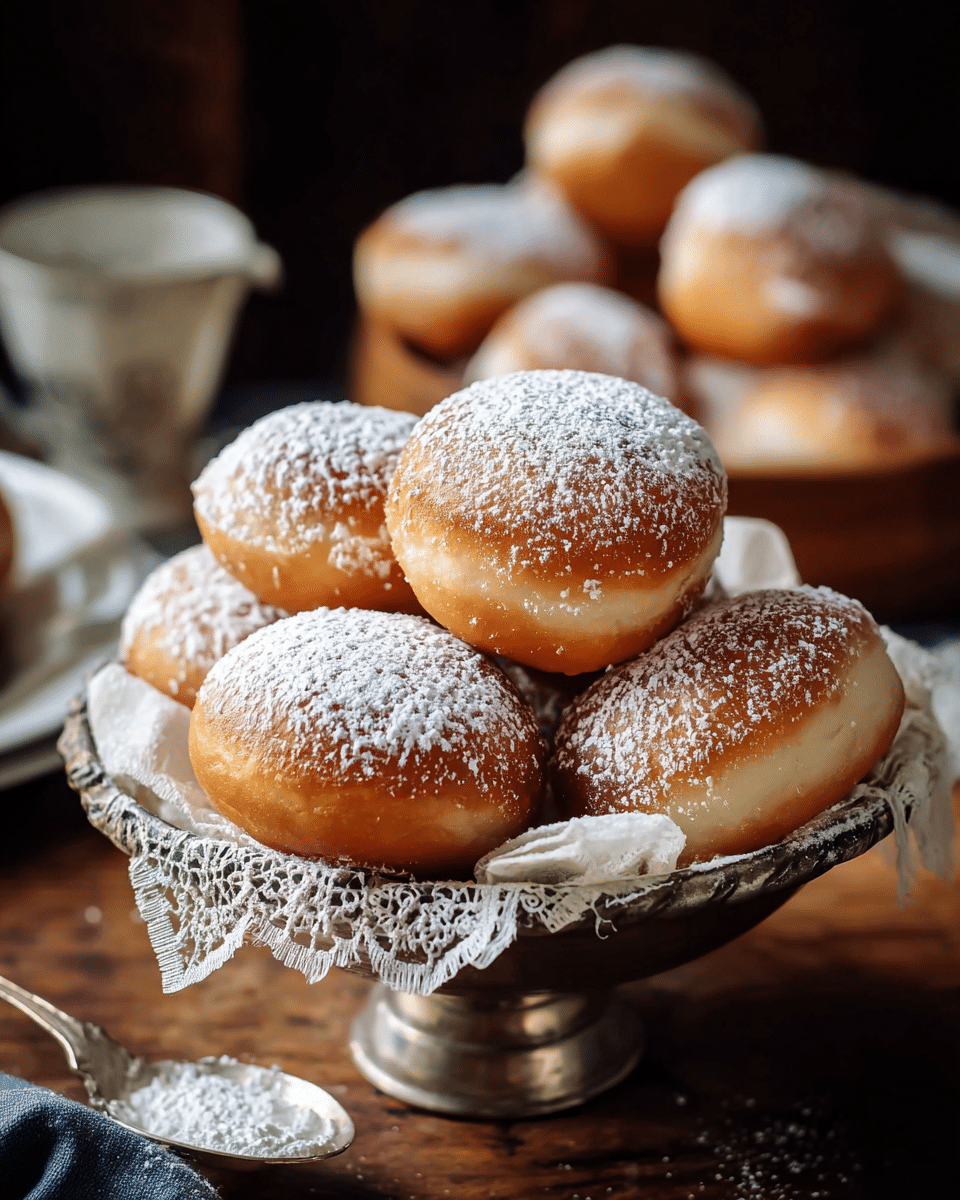These Vanilla French Beignets are the ultimate indulgence, crispy on the outside and soft on the inside, with a delicate vanilla glaze that melts in your mouth. The light, airy texture combined with the sweet glaze creates a heavenly dessert that’s perfect for any time of day.
Whether you’re enjoying them for breakfast, as an afternoon snack, or as a sweet treat after dinner, these beignets will elevate your culinary experience. They’re quick to make, yet elegant enough for special occasions. Serve them with a hot cup of coffee or a glass of milk for the perfect pairing.
Full Recipe:
-
1 cup all-purpose flour
-
1/4 cup sugar
-
1/4 teaspoon salt
-
1/2 tablespoon active dry yeast
-
2/3 cup warm milk
-
1 egg
-
2 tablespoons unsalted butter, softened
-
Vegetable oil (for frying)
-
1/4 cup powdered sugar (for dusting)
-
1 teaspoon vanilla extract
-
1/2 teaspoon ground cinnamon (optional)
Directions:
-
In a bowl, combine the flour, sugar, salt, and yeast. Mix well.
-
Add the warm milk, egg, and butter, stirring until the dough forms.
-
Knead the dough on a floured surface for about 5-7 minutes until smooth. Place it in a greased bowl and cover with a damp cloth. Let rise for 1 hour or until doubled in size.
-
Heat the oil in a deep fryer or large pot to 350°F (175°C).
-
Roll out the dough on a lightly floured surface to about 1/4-inch thickness.
-
Cut the dough into squares or rectangles using a knife or pizza cutter.
-
Carefully fry the dough pieces in hot oil for 2-3 minutes per side or until golden brown.
-
Remove from the oil and drain on paper towels.
-
In a small bowl, mix the powdered sugar, vanilla extract, and cinnamon. Dust the warm beignets with the vanilla glaze mixture.
-
Serve hot and enjoy!
Prep Time: 20 minutes | Cooking Time: 10 minutes | Total Time: 30 minutes
Kcal: 170 kcal | Servings: 12 beignets
History and Origin
The history of beignets dates back to ancient France, where they were originally called “pets de nonne,” or “nun’s farts,” which refers to the light and airy texture of the pastries. The name was eventually changed to beignet, which is French for “fried dough.” Historically, beignets were a popular treat in French bakeries, especially in regions like New Orleans, where the dish has become a hallmark of the city’s culinary culture.
In New Orleans, beignets are famously served with a cup of café au lait, typically at the iconic Café du Monde. The city’s French Creole heritage has long embraced this treat, and it has become a beloved staple at Mardi Gras celebrations and other festive events. While traditional beignets are made with a simple dough and fried to a golden crisp, this variation with vanilla glaze adds a modern touch to the classic recipe, offering a sweet and aromatic flavor profile.
Variations and Adaptations
Beignets can vary significantly depending on the region or culture, particularly in the fillings and toppings used. For example, the classic French beignet recipe calls for simple fried dough without any filling, but in some regions, they are stuffed with fruit preserves or chocolate. New Orleans-style beignets, as mentioned, are a famous variation, often dusted with a heavy coating of powdered sugar.
In addition to the traditional beignet, variations may include flavorings like cinnamon, nutmeg, or lemon zest mixed into the dough, while others may be drizzled with fruit syrups, chocolate sauce, or in this case, a sweet vanilla glaze. The addition of vanilla elevates the flavor profile, adding a rich and aromatic note that pairs beautifully with the fried dough’s crispy texture.
If you’re in the mood for a different twist, you can also try savory versions of beignets, where ingredients like cheese, herbs, or even minced meat are added to the dough before frying. However, for those with a sweet tooth, the vanilla glaze on these beignets provides an irresistible finish.
Nutritional Information
While French Beignets are undoubtedly a delicious treat, they are best enjoyed in moderation due to their rich ingredients and deep-frying method. One serving typically contains about 170 calories, depending on the size of the beignet and the amount of glaze or powdered sugar used. Here’s a breakdown of the typical nutritional content per serving:
-
Calories: 170 kcal
-
Carbohydrates: 23 grams
-
Protein: 2 grams
-
Fat: 8 grams (with a higher content of saturated fat due to the butter and oil used in frying)
-
Fiber: 1 gram
-
Sugars: 7 grams (mostly from the powdered sugar and glaze)
Micronutrients such as calcium, iron, and magnesium are present in small amounts due to the use of milk and butter, but beignets are not a significant source of these vitamins and minerals. The high sugar content, combined with the frying process, means that while beignets are delicious, they are also calorie-dense and should be eaten as a treat rather than a daily indulgence.
For a healthier twist, you could try making a baked version instead of frying, though this would change the texture and crispiness of the beignet. Additionally, substituting butter with a plant-based option could make the dish suitable for vegan diets.
Serving Suggestions and Pairings
Vanilla French Beignets can be served in a variety of creative ways, making them versatile for different occasions. Here are a few serving suggestions:
-
Classic Café Pairing: Serve beignets with a steaming cup of café au lait, a French classic that complements the sweetness of the beignets perfectly. The smooth, strong coffee balances the rich flavors of the beignets, offering an authentic French experience.
-
Brunch Treat: These beignets are an excellent choice for brunch, paired with fresh fruits like strawberries, raspberries, or a citrusy fruit salad. A dollop of whipped cream or a scoop of vanilla ice cream would also add a luscious touch to the dessert.
-
Mardi Gras Celebration: For a themed event like Mardi Gras, serve these vanilla beignets on a large platter, dusted generously with powdered sugar. Pair them with a fruity cocktail, like a French 75 or a classic mimosa, for an elevated celebration.
-
Afternoon Tea: Beignets also make a wonderful addition to a refined afternoon tea spread. Serve with a selection of teas, from black to herbal varieties, ensuring there’s a balance of sweetness and bitterness in the drink options to complement the pastry’s richness.
Tips and Tricks for Success
To ensure that your Vanilla French Beignets turn out perfectly, follow these expert tips:
-
Proper Dough Resting: Allow the dough to rise properly for the best texture. The dough should double in size, which typically takes about an hour. A longer rise will make the beignets lighter and fluffier.
-
Fry at the Right Temperature: It’s crucial that the oil is at the correct temperature, around 350°F (175°C), to avoid soggy beignets. If the oil is too hot, they’ll brown too quickly on the outside while remaining raw inside. Too cool, and they’ll absorb too much oil and become greasy.
-
Use Fresh Ingredients: For the best flavor, make sure your yeast is fresh and your milk is warm but not too hot—hot milk can kill the yeast. Fresh vanilla extract also enhances the beignets’ aroma, adding a depth of flavor that imitation vanilla simply can’t replicate.
-
Avoid Overcrowding the Pan: When frying, be sure not to overcrowd the pan. This can cause the temperature of the oil to drop, resulting in oily, unevenly cooked beignets.
Potential Health Benefits
While French Beignets are a decadent treat, there are a few potential health benefits to consider:
Advertisement
-
B Vitamins: The ingredients in beignets, particularly the flour and milk, provide small amounts of essential B vitamins, which help with energy metabolism.
-
Calcium: The milk and butter used in the recipe offer a modest amount of calcium, which is crucial for bone health.
However, due to the sugar and fat content, beignets are not typically classified as a health food. That being said, the indulgent qualities of this treat can provide a mental health boost and offer a moment of joy and relaxation when enjoyed in moderation.
Conclusion
Vanilla French Beignets are a timeless treat that brings a touch of elegance and indulgence to any meal. Their crispy exterior, soft interior, and sweet vanilla glaze make them an irresistible option for dessert, brunch, or a celebratory occasion. While not a health food, the enjoyment these beignets bring is well worth the occasional indulgence. So, whether you’re craving something sweet to accompany your coffee or looking for a fun treat to share with friends and family, these beignets will never disappoint.
Try them out today and treat yourself to a little bit of French culinary bliss!






